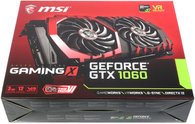
In the future, one will have to pay more attention to the designation or the specified memory in the 1060s – because with 1152 instead of 1280 shaders, the GP106-300 GPU offers exactly 10 percent less theoretical computing power than the normal GP106-400.
In addition, the memory is halved from six to a miserable three gigabytes, which could already be very scarce with current titles in full HD. Today's test is intended to clarify whether and how much this is the case.
By the way, we already took the map at the end of August in the form of a "mini-launch" in a single review and list it in this roundup only for the sake of completeness.
It is not surprising that these cards were first presented in Asia, because the market there is much different and also cards like this GeForce GTX 1060 "Light" will certainly be a guaranteed satisfied clientele among the millions MMORPG players.
External structure and connections
As with the larger sister models, the radiator cover is made entirely of relatively thin plastic, but a very solid mounting frame under the lid provides more stability.
The card is not lightweight at 1001 grams – it is only two grams lighter than the MSI GeForce GXT 1060 Gaming 6G, the "normal" GTX 1060. This minimal saving is probably due to the use of other memory modules, as we will show in a time.
The rest is completely identical, because the card also measures 28.4 x 13.5 x 3.5 cm (LxHxT, installation dimensions), occupies two full slots and is also relatively high. The rotors of the two double ball-bearing fans have the same diameter of 9.5 centimeters as for the larger sisters.
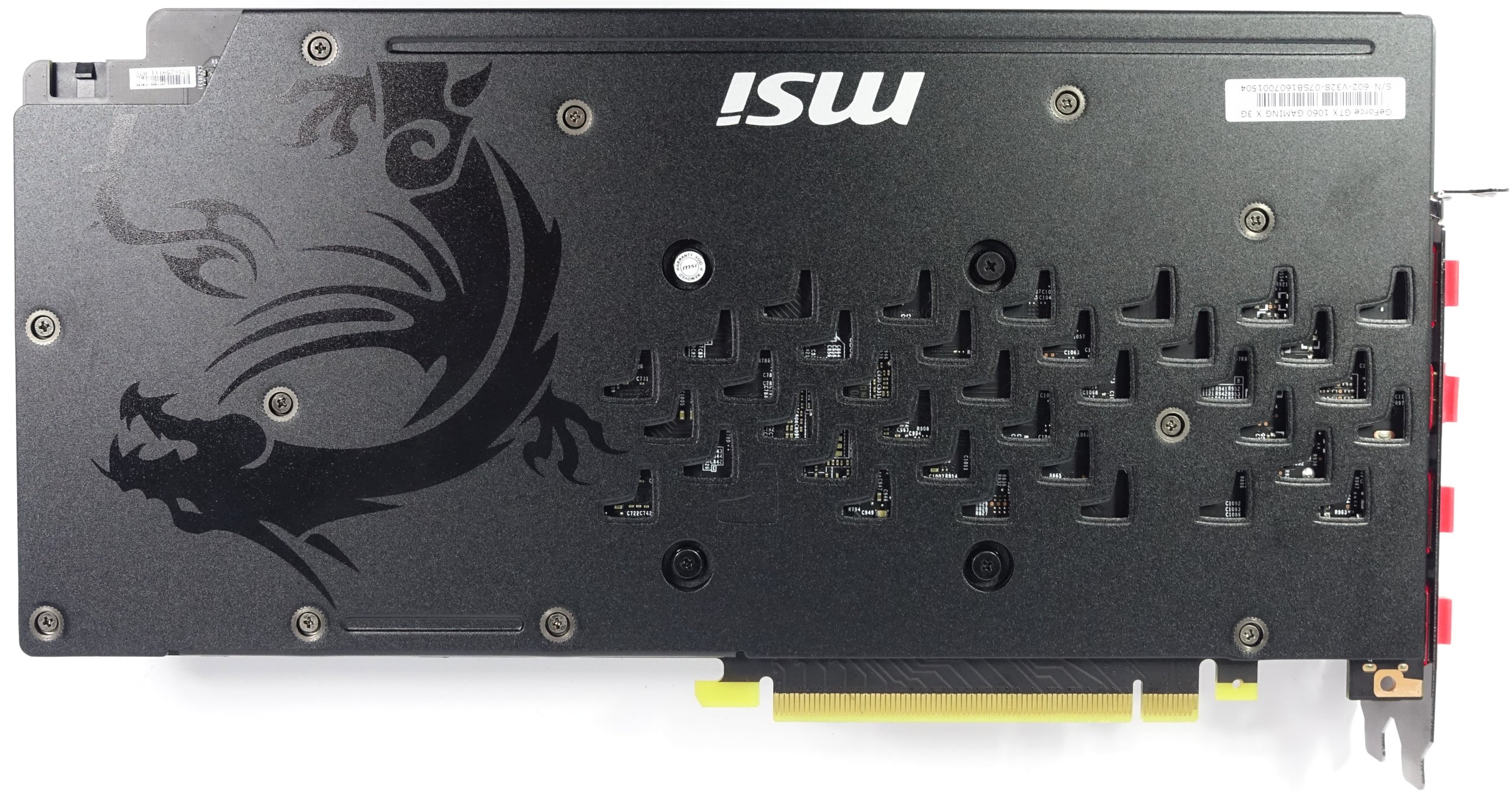 |
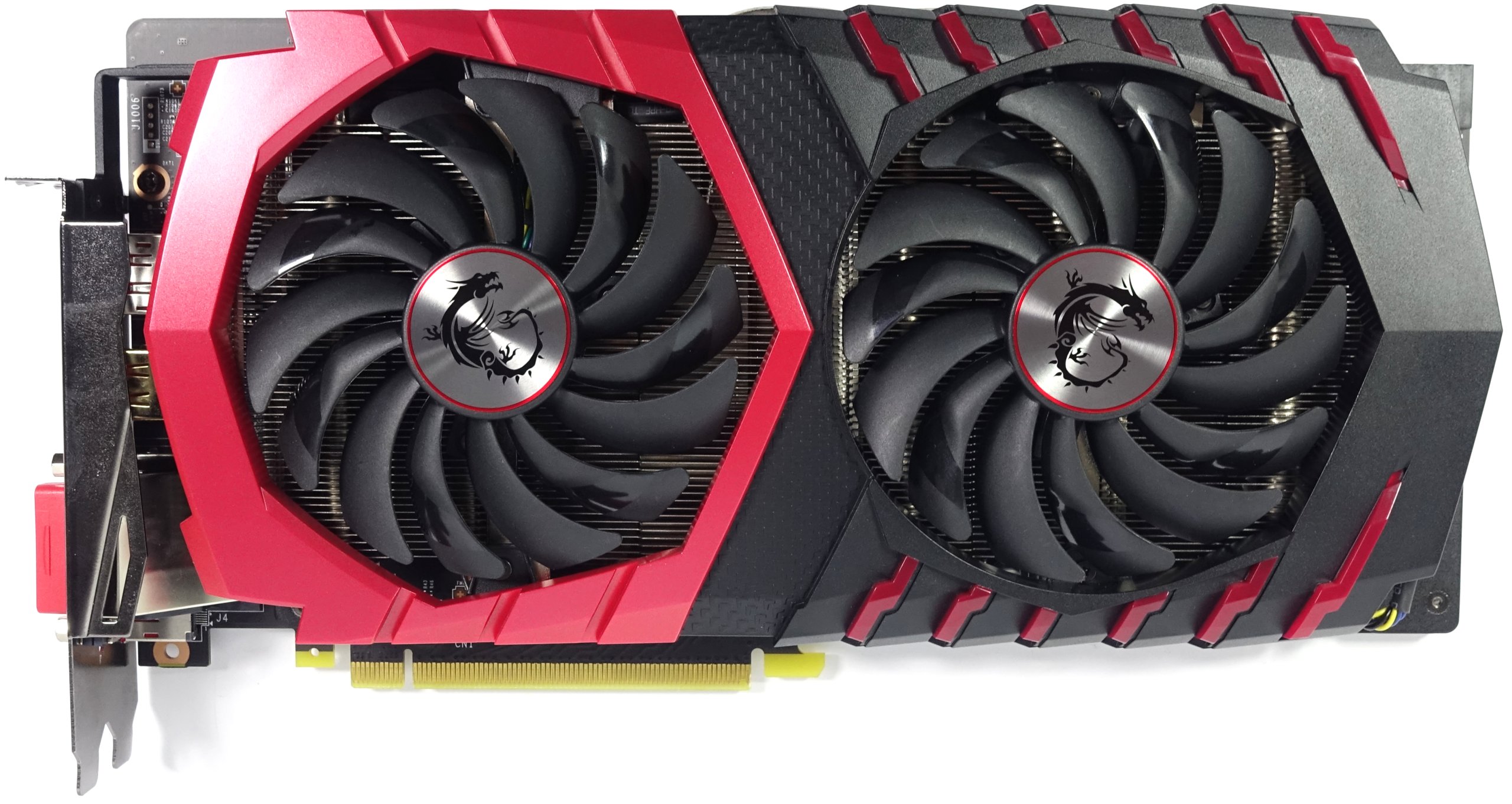 |
The back of the board is covered by a one-piece backplate, which has ventilation openings, but is completely functional due to the lack of areas connected to thermal guide pads. With this backplate you have to plan another five millimeters depth on the back. If you need to use the top board slot and possibly use a large CPU cooler, these few millimeters can be decisive.
The bottom shows two of the three nickel-plated composite heatpipes, of which the two 6 mm variants are continuous and supply both parts of the heat sink with waste heat.

The top of the map bears a luminous MSI lettering and, as with the other two models, is characterized by a total of three visible heatpipes (twice six and once eight millimeters), of which we already know the two smaller ones from the bottom . The 8-pin PCIe power supply connector sits 180° rotated at the end of the card.

The end of the map is again completely open, as the slats are horizontally aligned and thus the air flow towards the end of the map or Slot aperture goes. This is advantageous in that a not inconsiderable part of the waste heat is already passed out of the housing via the slot aperture.
The slot aperture carries a total of five outputs, a maximum of four of which can be used together as part of a multi-monitor setup. In addition to the dual-link DVI-D (an analog signal is not looped through), there is an HDMI 2.0 output and three DisplayPort 1.4 ports on the back.
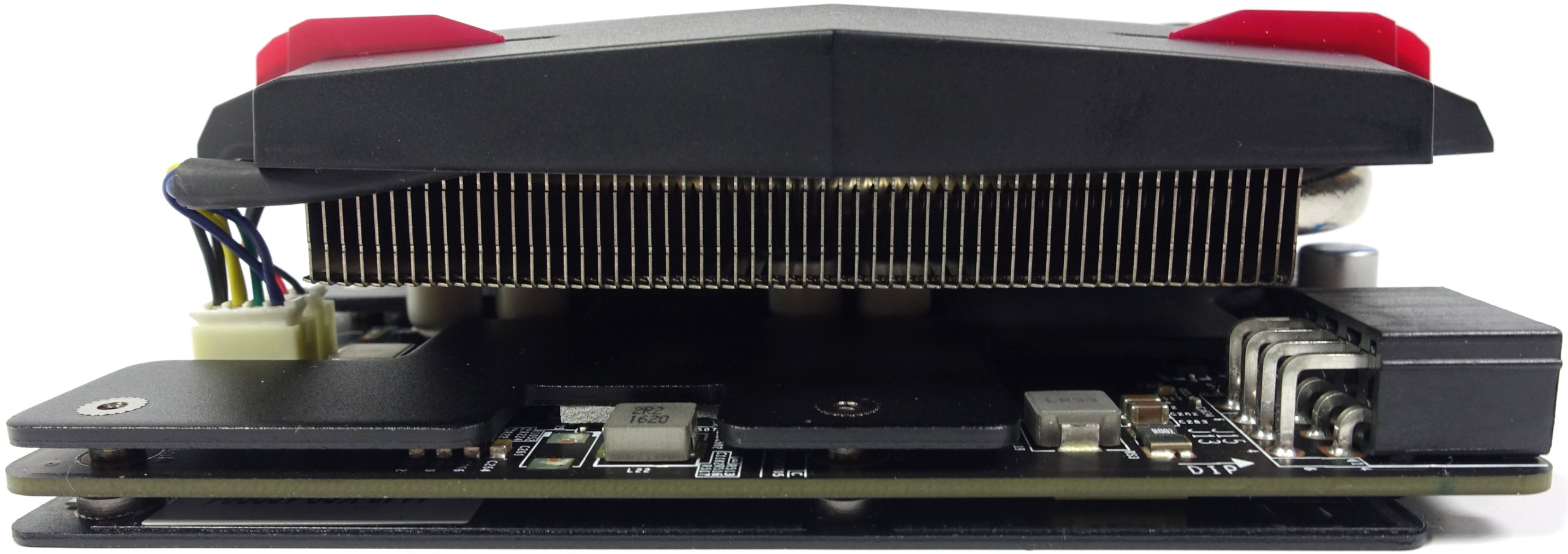 |
 |
The rest of the slot aperture is provided with some openings for the air outlet. If the DVI connector – usually over-fed – had been omitted altogether and optionally included an adapter, then the effectiveness of the ventilation could certainly have been increased.
Board and assembly
A glance at the board shows us that at first glance it is completely identical to the bigger sister. All five phases are fed from the PCIe connector, only the memory is supplied in a separate phase via the motherboard slot. In addition, even more later when it comes to measurements of power consumption and flowing currents.
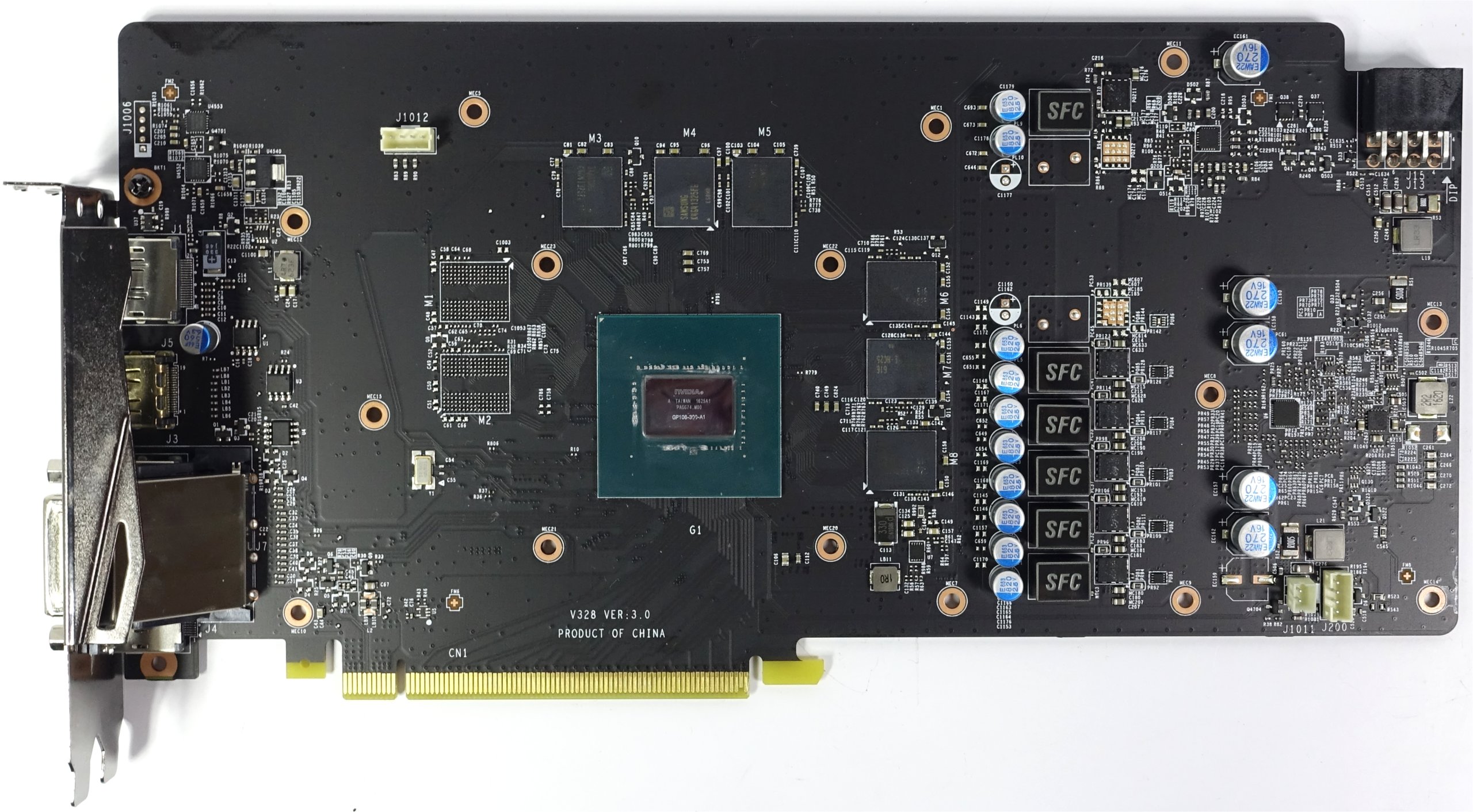
The five converter hoists of the GPU power supply are controlled by a uP9511P from uPI Semiconductor Corp. As the actual voltage converter for the high and low-side, MSI relies on dual-N-channel MOSFETs of the M381 family, which do not require an additional gate driver, which saves immense space (and probably also costs).
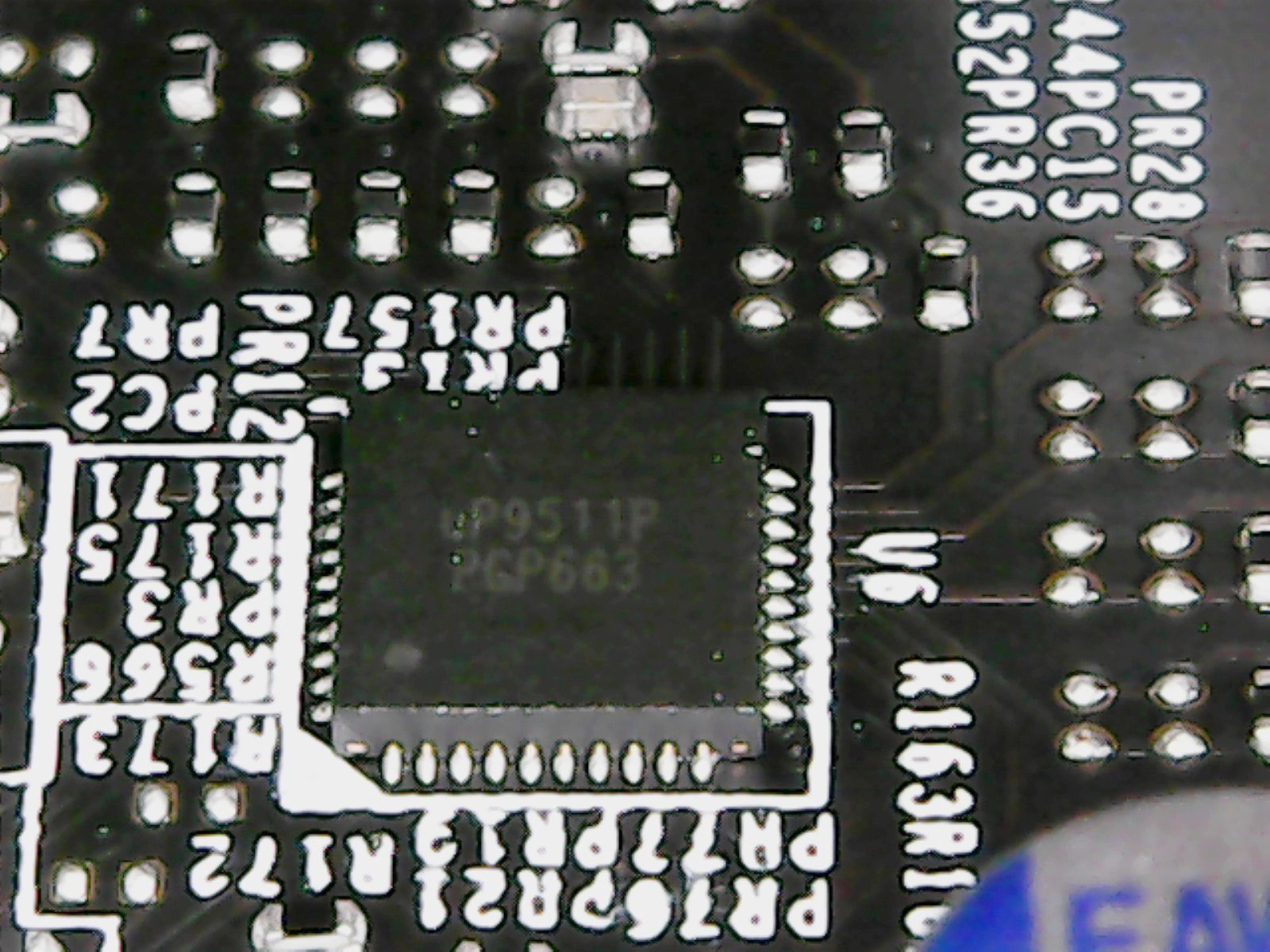 |
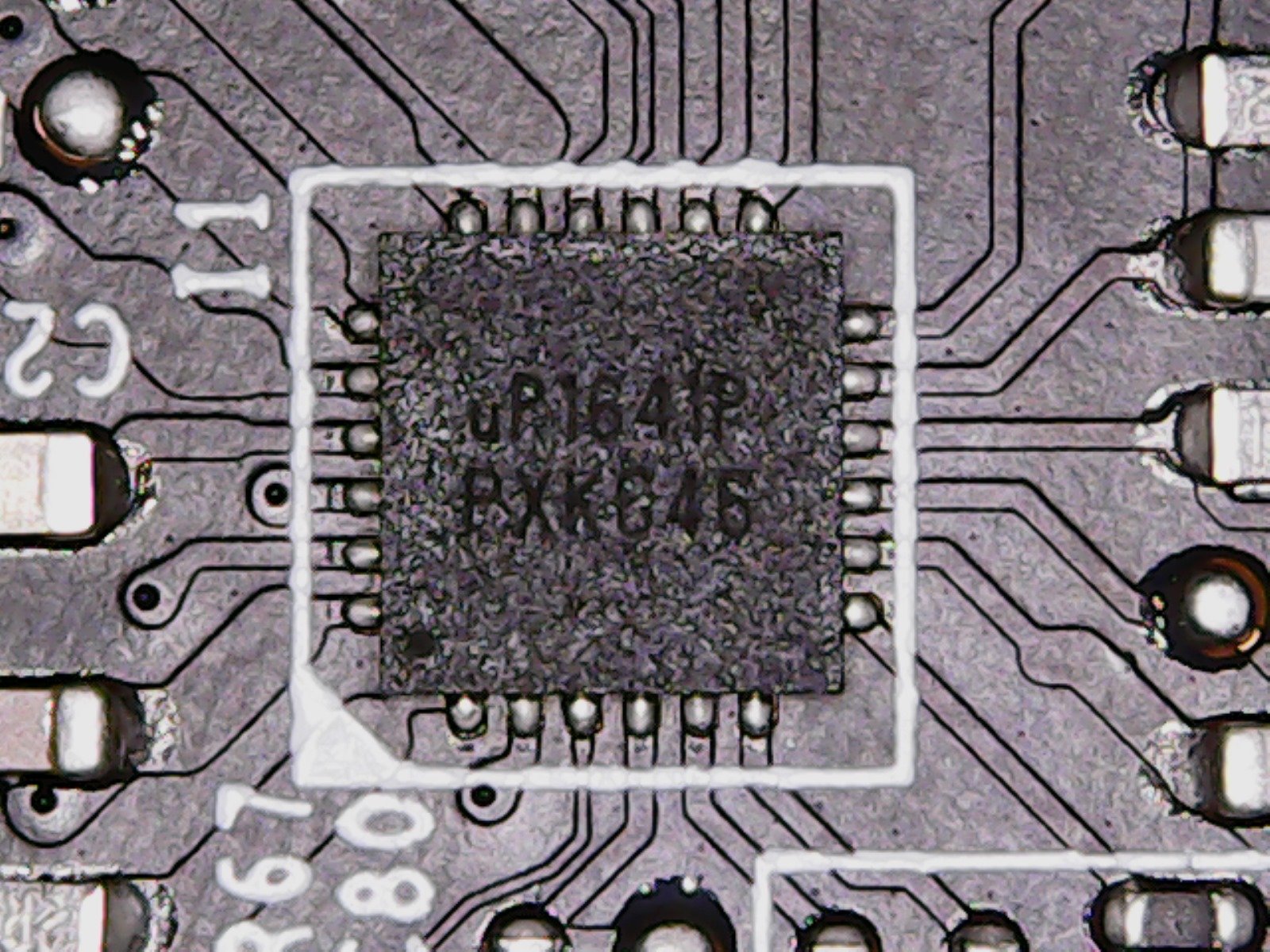 |
A small uP1641P from uPI Semiconductor Corp. is used for the one converter of the power supply of the memory, but this time an SM7320 serves as a voltage converter, which is also a dual-N-channel model.
The coils used by MSI for years are neither above average good nor particularly bad, but acceptable mass-produced goods, which are reasonably solidly encapsulated. They are definitely better than Foxconn's Magic Coils, but they have to be assembled manually.
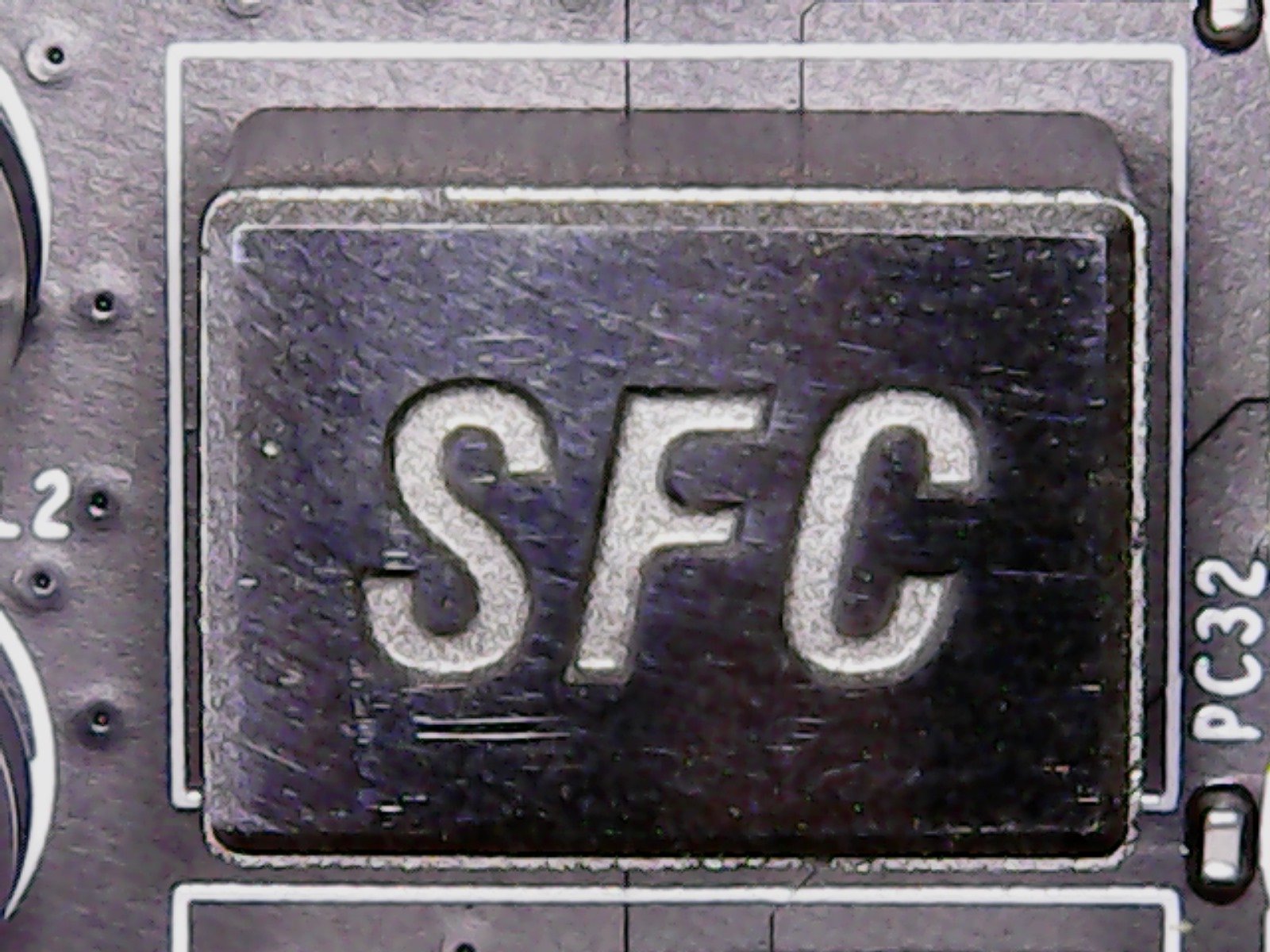 |
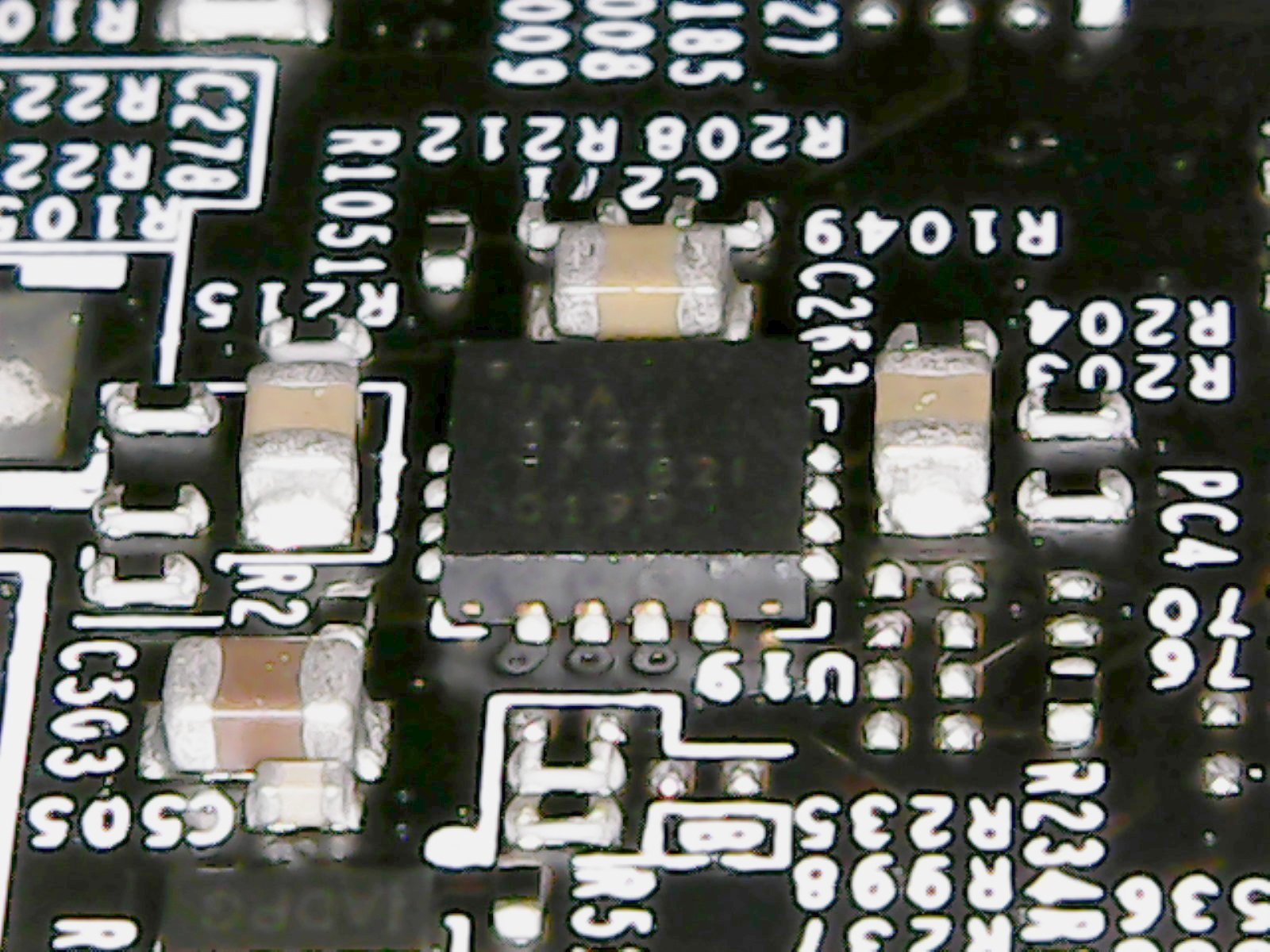 |
An INA1221 is used to monitor the flowing currents. We will later find that a power target generously sized in the firmware hardly arrives in reality if you overdo it so extremely like MSI. In fact, Nvidia also uses an internal ankle shackle, which ensures that overclockers are almost stuck on the ground of reality.
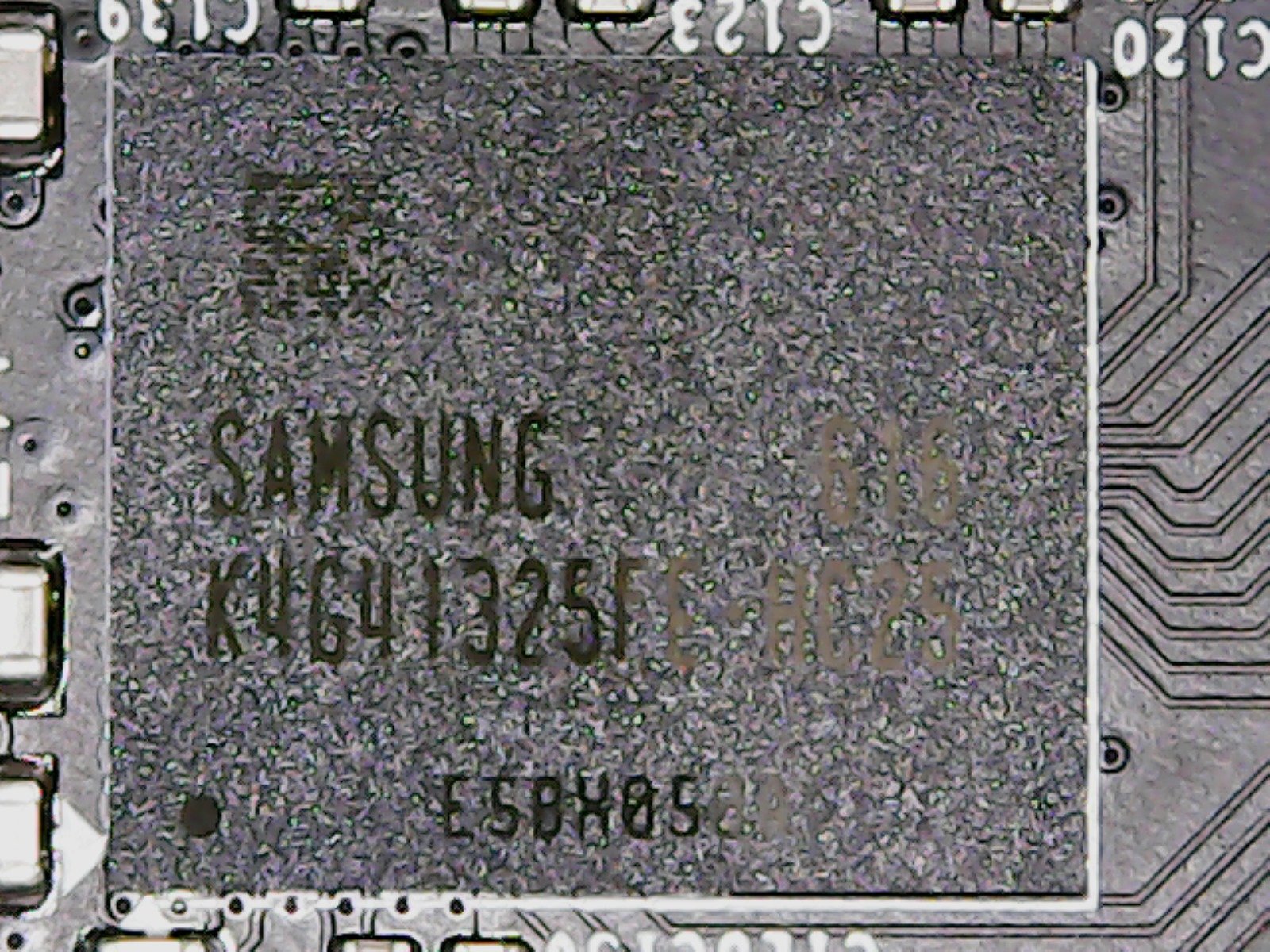
It is of course noticeable that in the GTX 1060 only six of the eight existing memory fields are filled with modules. These are Samsung modules of the type K4G41325FC-HC25 with a capacity of four gigabit (32x 128 MBit each), which can be operated with voltages between 1.305 and 1.597 volts depending on the required clock. In total, this results in a total memory of only three gigabytes.
Below the GPU, by the way, two capacitors are soldered to intercept and smooth voltage peaks – exactly the same principle as with Nvidia's Refrenz.
Clock rates, voltages and power consumption
First, let's consider the boost clock, which drops from a proud 1974 MHz ex works even after complete warming by only one level to 1949 MHz.
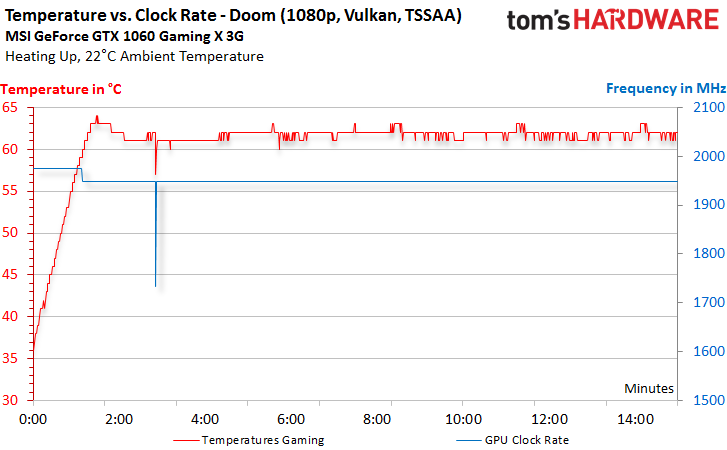
Of course, the voltage also follows this trend, because from 1,062 volts it goes down to 1.043 volts, which corresponds exactly to what would have been expected for the slightly lower boost step.
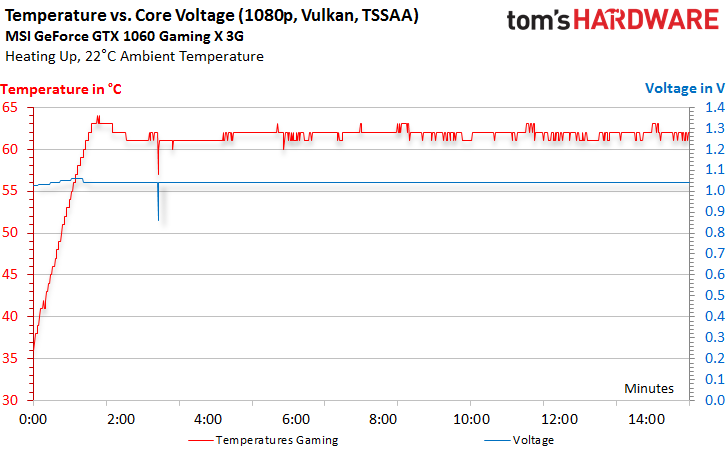
These voltage curves and the flowing currents result in the already mentioned power consumption, which we can measure very well with our exact equipment at all connections.
In addition to the usual measurements, we have of course also included other games with different rendering paths and settings. However, we have limited the resolution to 1920 x 1080 pixels (Full HD), because for more, this card with only three gigabytes of memory is hardly usable.
While in the idle and also at lower load conditions a very similar power consumption to the GP-106-400 could be measured, this decreases more significantly under load as expected. This time, the highest value was not Doom, but Metro Last Light, but the frame rates here were already well in the basement. Also with The Witcher 3 we would have had to significantly reduce the maximum settings for playable frame rates.
If we had adjusted these details in the direction of real playability, the power consumption would be similar to Doom with approx. 102 to 103 watts was significantly lower. We already see this as the first indication that the narrow memory expansion limits the card more than you might like. That's why, for all the rest of this map, we only use Doom for all the rest of this map, because we don't want to get too far away from reality.
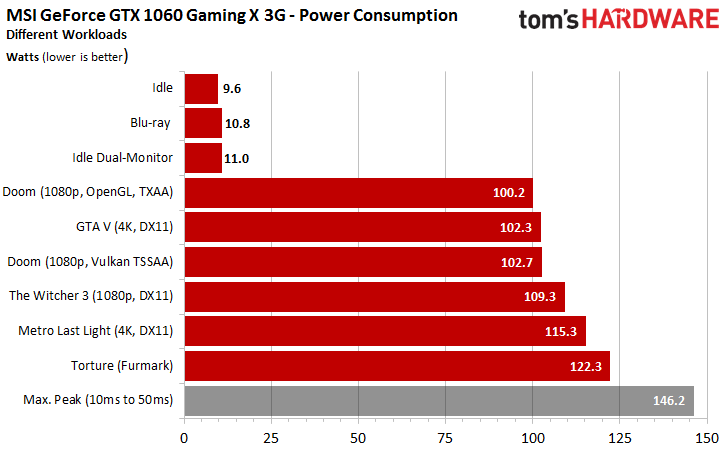
The peak value, executed as a grey bar, represents the short load peaks remaining in the form of a maximum value despite the smoothing described at the beginning and is of no real importance in practice. Because the periods are still far too short to have possible consequences and therefore not relevant enough for an influence on our assessment. Due to the smoothing, the really short-term extreme load peaks are no longer taken into account anyway. Ergo is more of an informative yardstick.
Loading of the power supply connections
Now we'll go into more detail and look at the load sharing with proper (and real) gaming load as well as the stress test. What is important to us here is the balance between the two 12-volt supply rails, i.e. the motherboard slot and the external PCIe connection. With less than 30 watts in the stress test (approx. 21 Watts in gaming) the motherboard slot is only slightly loaded.
This can be attributed to the fact that only the memory and board components (LED, fan, video, etc.) are powered by this rail, but the GPU is fully attached to the PCIe port. Now we also understand why MSI gave the card an 8-pin connector, even though the total power consumption in each scenario remains very much below 150 watts.
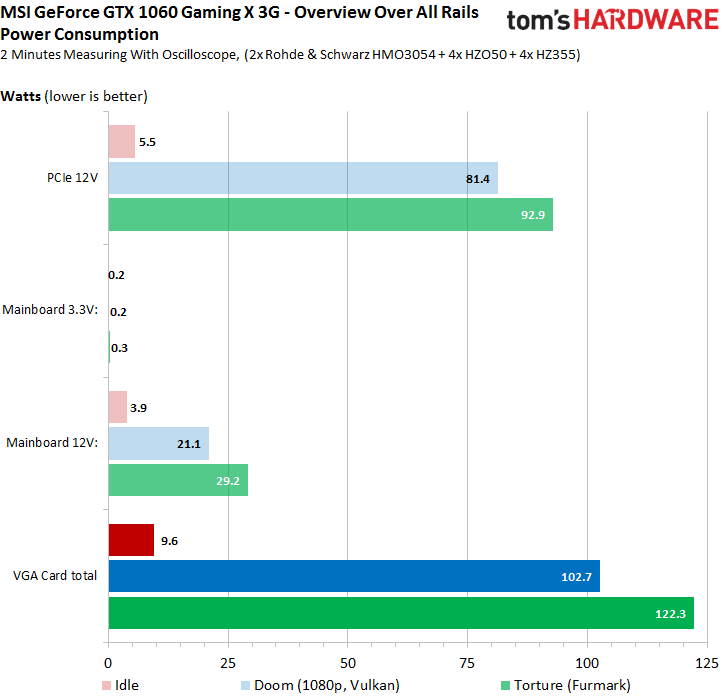
Here's another clickable diagram with the respective history curves for gaming and stress testing:
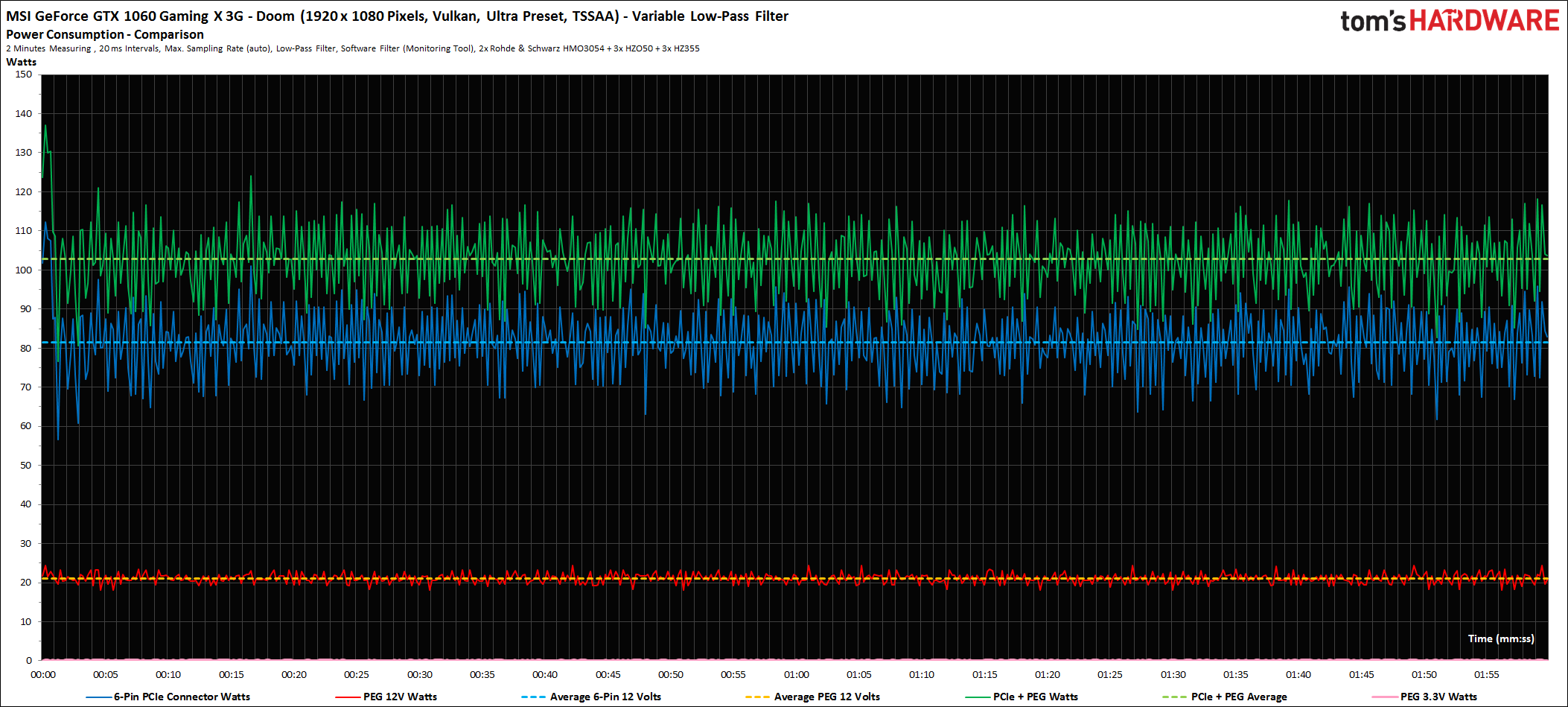 |
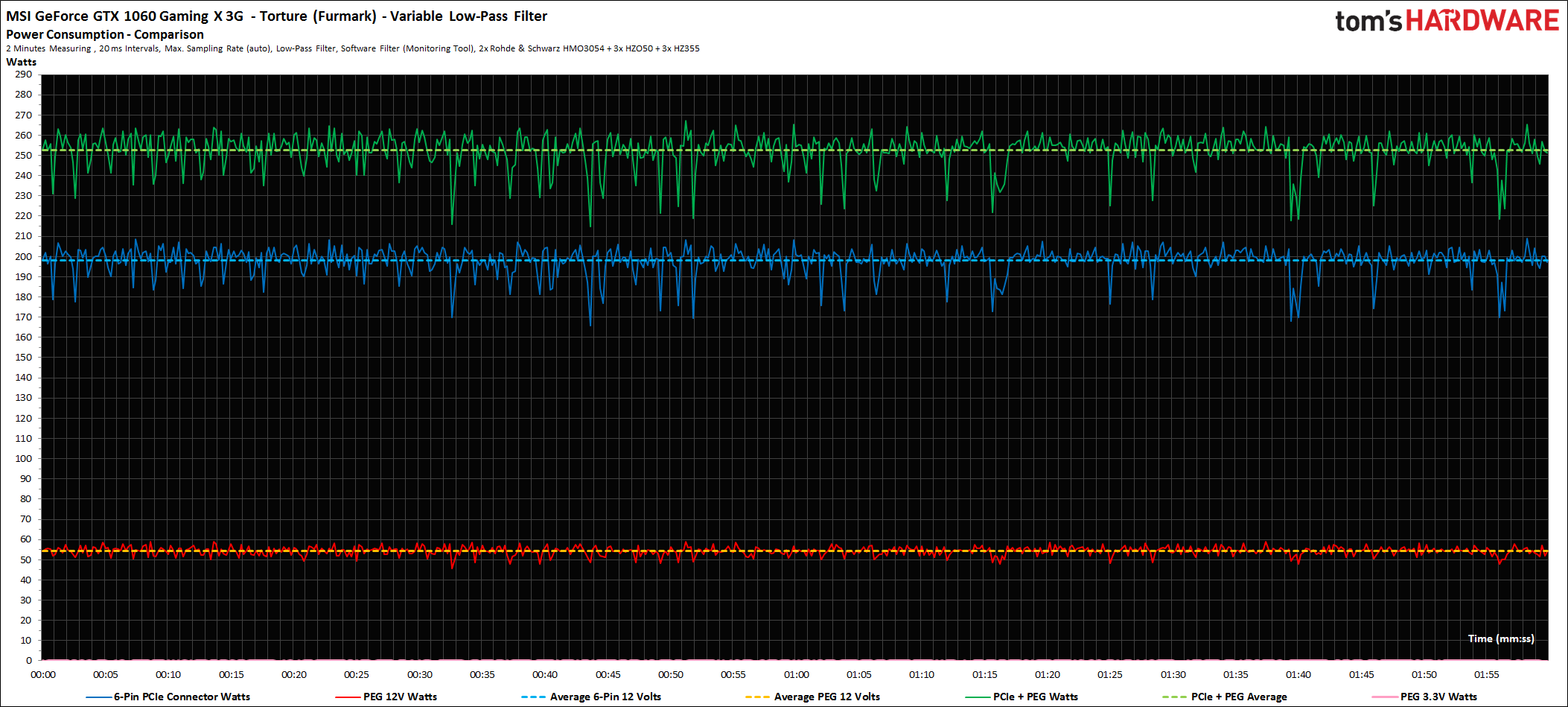 |
Since the standards (PCI SIG) refer only to the flowing currents, we now look at the following diagrams, because the power consumption is only half the rent. With well below 2.5 amperes on the motherboard slot, one is also fully in the dark green standard range in this view, which is not surprising after determining the low power consumption values for this supply connection.
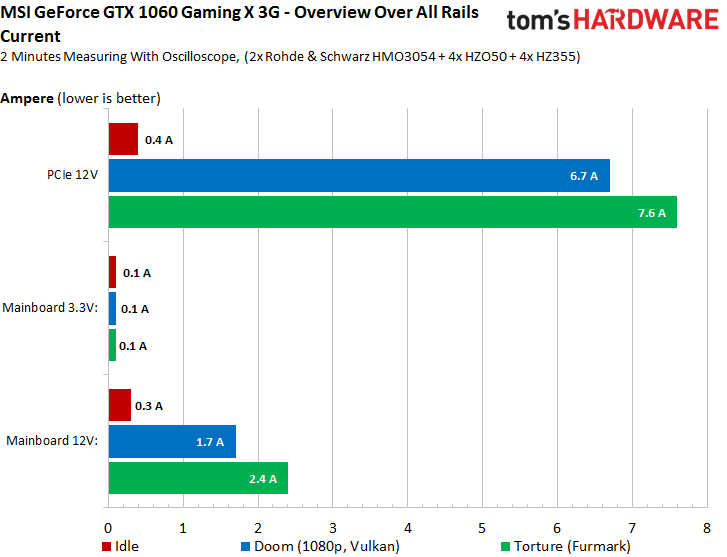
Of course, there are still clear large screens for the measured currents:
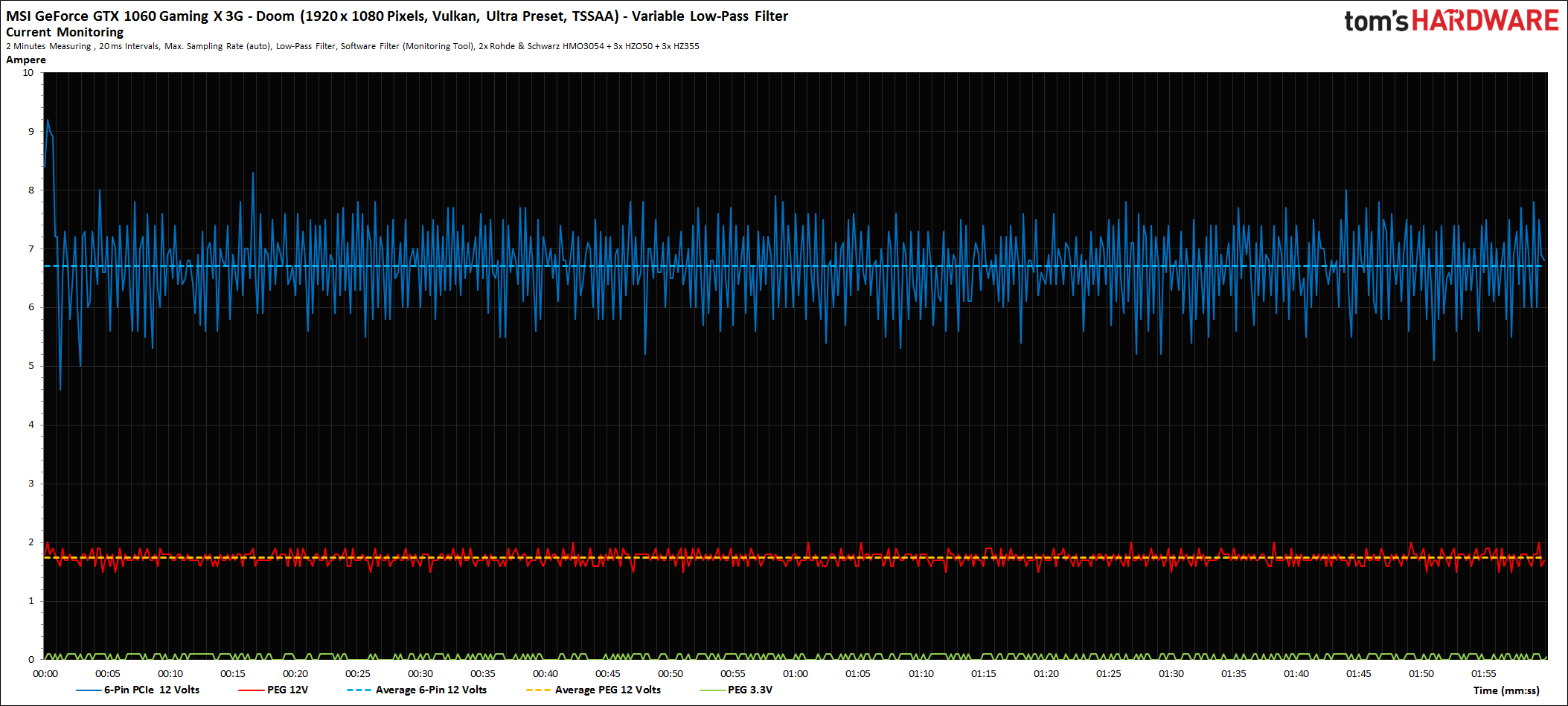 |
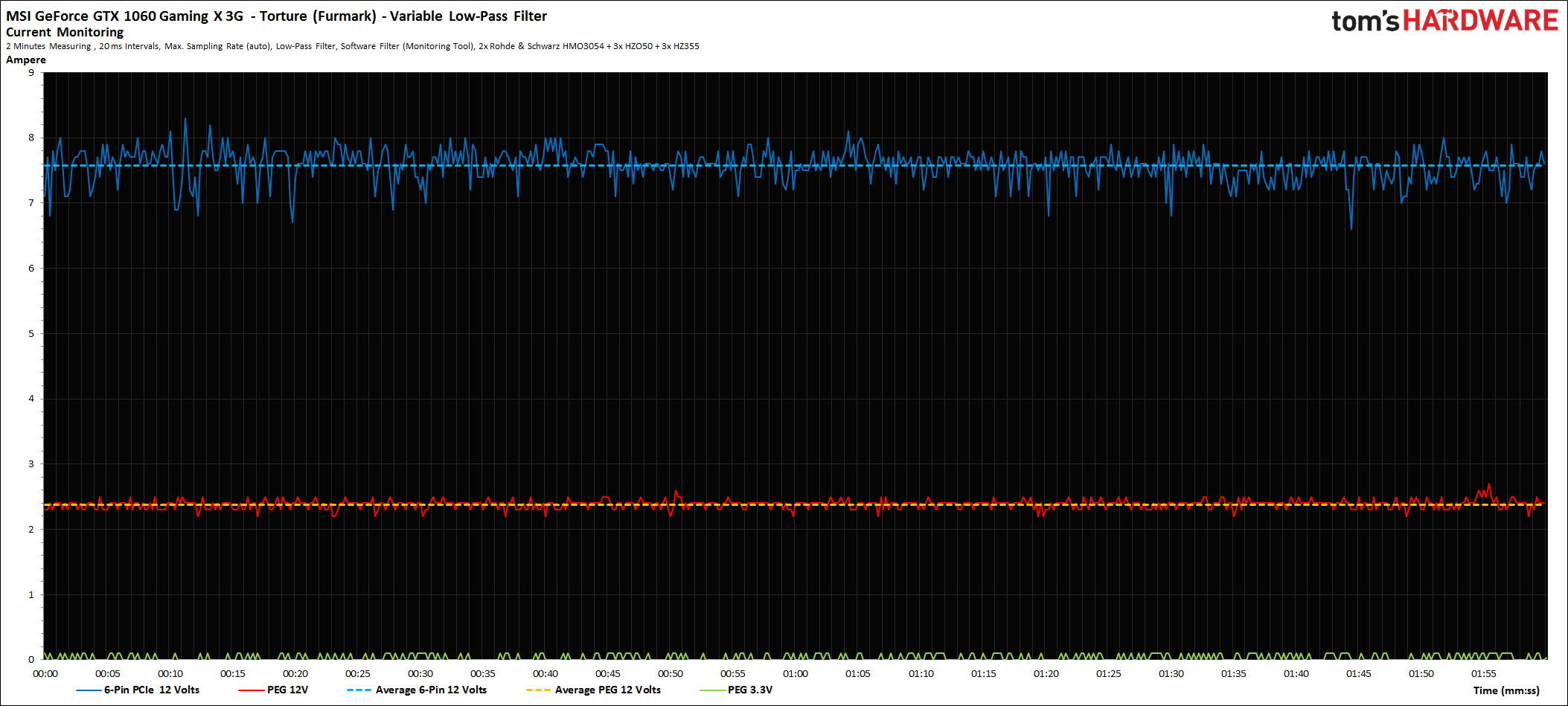 |
Cooling system and temperatures
The already mentioned backplate and the mounting and cooling frame sitting on the top of the board form a massive unit due to the rear screwing, which on the one hand cools on the top and on the other hand for a sandwich-like stabilization of the very heavy card.
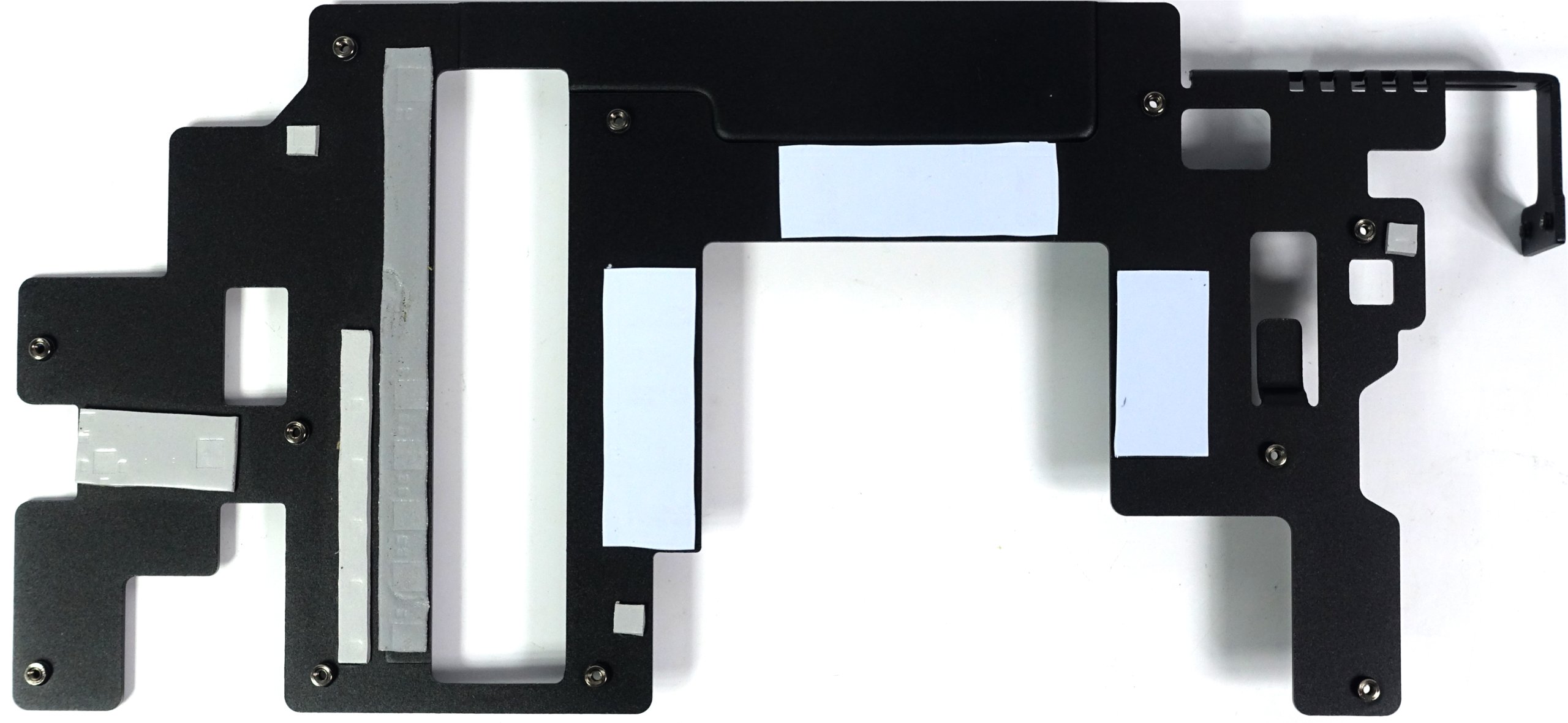 |
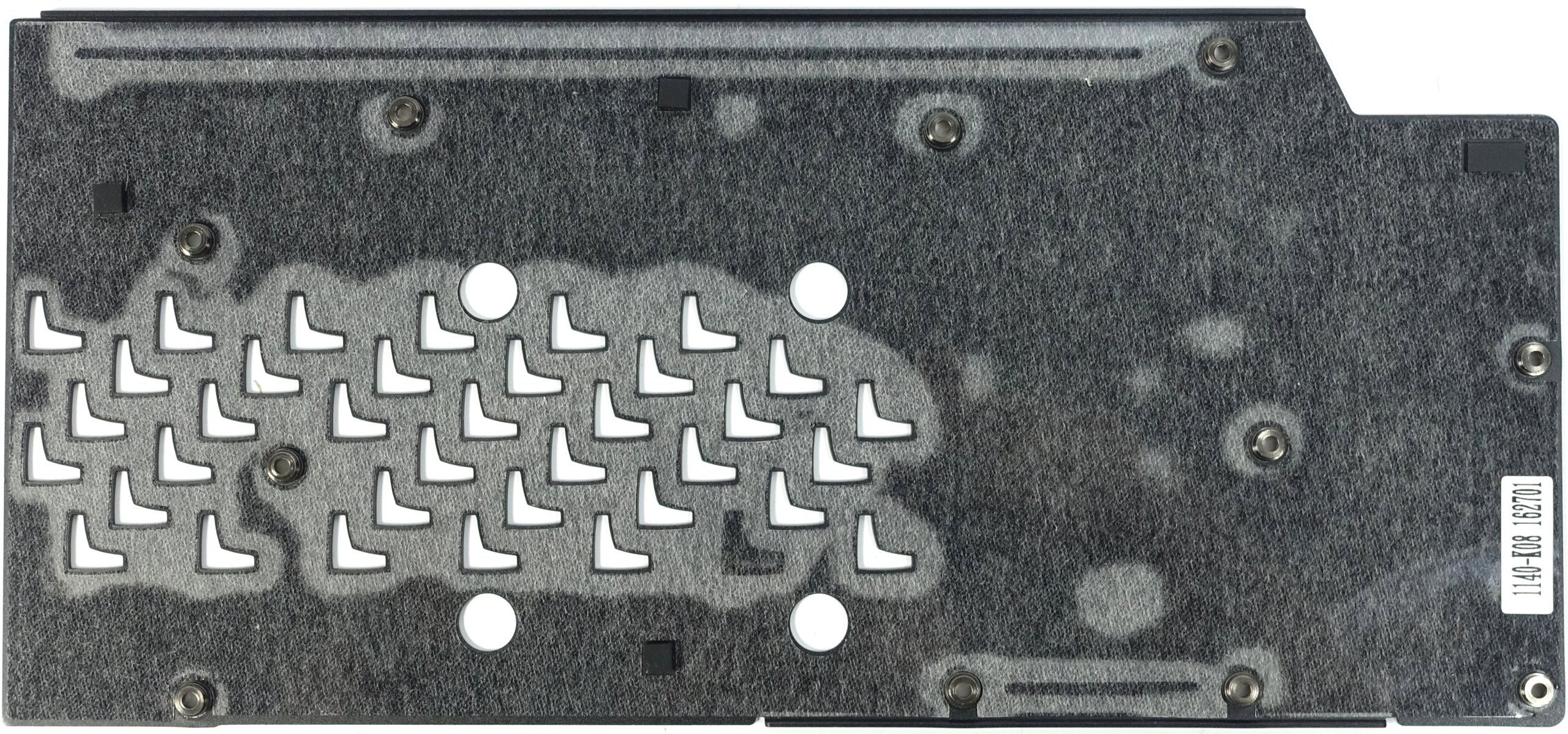 |
The frame itself is additionally screwed with the slot aperture and covers most of the top. With the thermal control pads, MSI not only cools the memory modules and the MOSFETS of the voltage converters, but also the two PWM controllers and the individual voltage converter for the component supply.
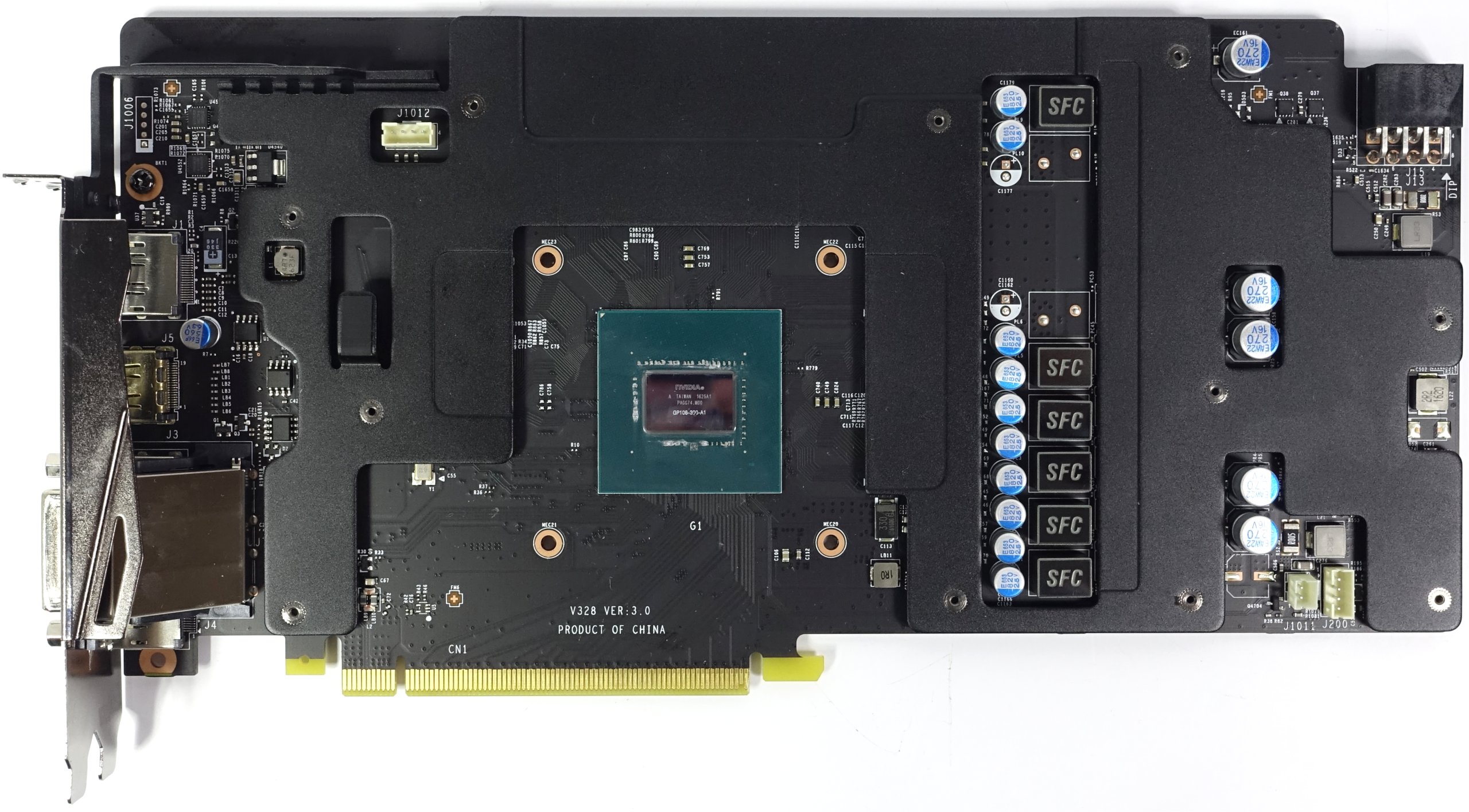
The heat sink is identical to the MSI GeForce GTX 1060 Gaming X 6G and offers a nickel-plated heat sink that presses the flattened heat pipes to the bottom of the top of the radiator floor through the screw connection. As with its larger sister, MSI has dispensed with a solid base plate with pressed heatpipes, unlike the GeForce GTX 1070 Gaming X 8G or GeForce GTX 1080 Gaming X 8G.
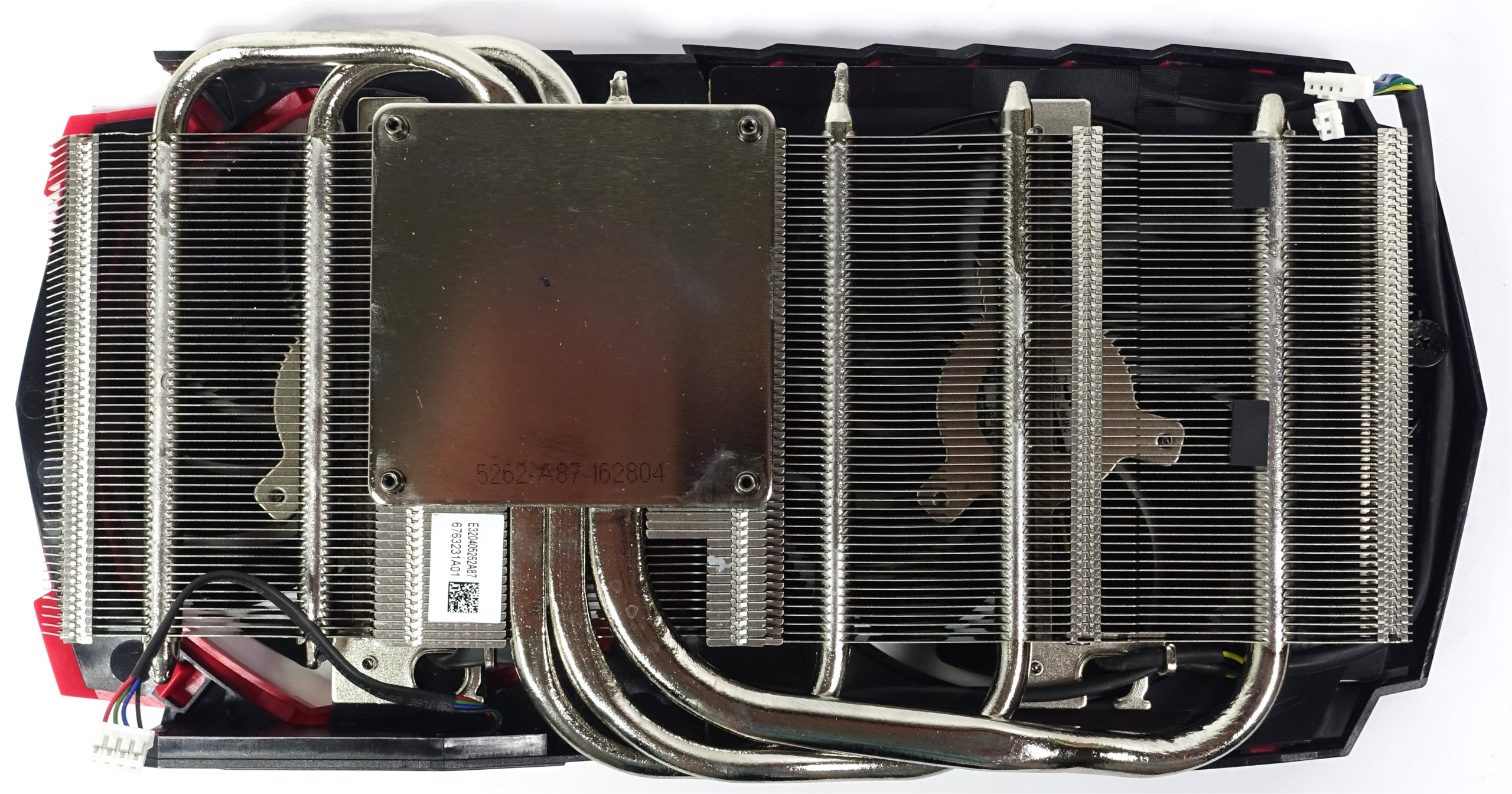
But where do temperatures end up under load? We see in the graph, which shows the temperature curve in direct relation to the gaming performance, that the actual frame rate at the statically selected measurement point in the game does not change with values from 79 to 80 FPS (with some game-related spikes).
On the one hand, we can assume that the boost clock is not slowed down by the temperature, and on the other hand, we know the actual brakes from our benchmarks. We will also find the small game-related dent in the other evaluations – which also shows how synchronous the measurements can now be.
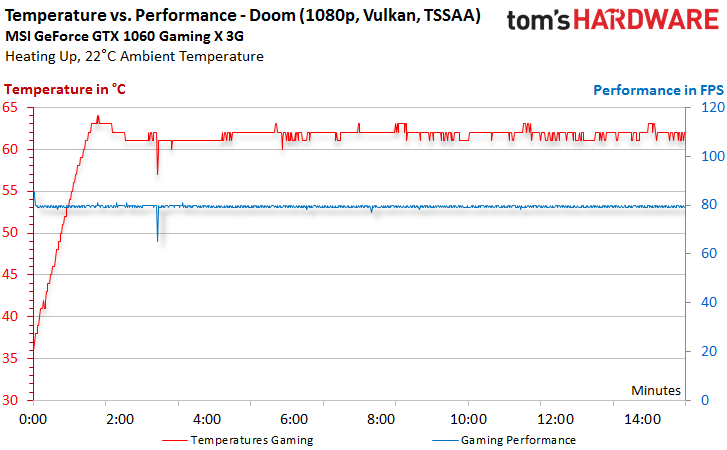
The GPU, with its temperature measured below the base, is pretty much exactly the measured value that the GPU diode emits inside as the sensor value. This applies to both the gaming and torture loops.
The voltage converters and memory modules are thermally completely in the safe range. Directly below the modules, the temperature is well below 70°C, even if the specification would allow temperatures of up to 85°C. And at just under 73°C, the voltage converters almost have ice age.
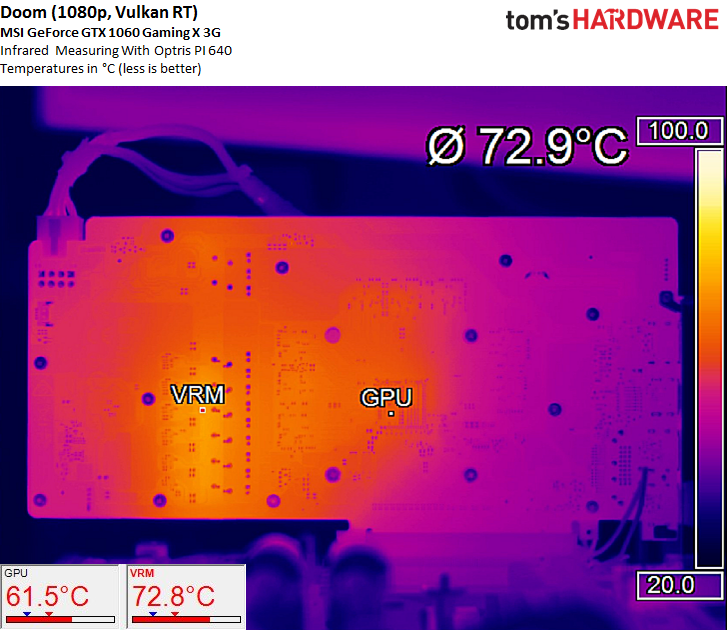
In the stress test, a solid 77°C is then achieved in the range of the five GPU voltage converters, with the warmest memory modules remaining below the 75°C mark. So there is definitely nothing wrong with cooling.

Noise
Let's move on to the fan curve. The two large fans rotate almost at the minimum speed at which they are started, but also remain well below 900 rpm in the stress test. This is practically no longer audible from a distance of about 50 centimetres and even at a lower distance one will rather guess or see the fan operation than perceive it acoustically.
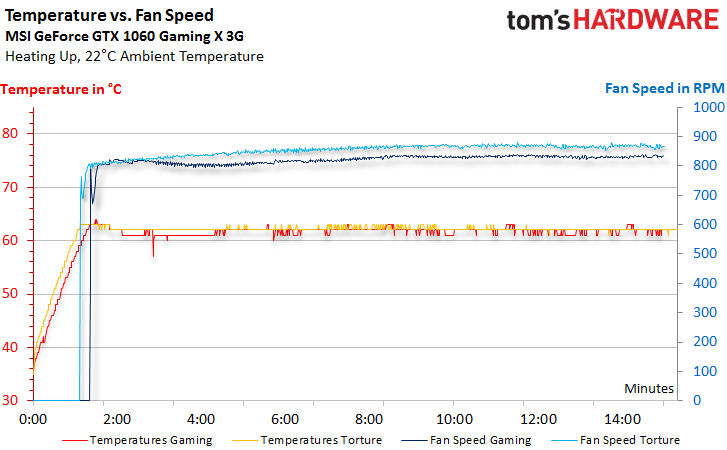
In the idle are the fans, which is why we can of course do without an indication. In gaming, we achieve an extremely good value of 29.3 dB(A), which at the top comes from the slightly lower storage noises. The actual fan noises are then completely lost in the "basic noise" of the card. It is in fact a card that can no longer be perceived acoustically under normal domestic conditions and installed in the housing.
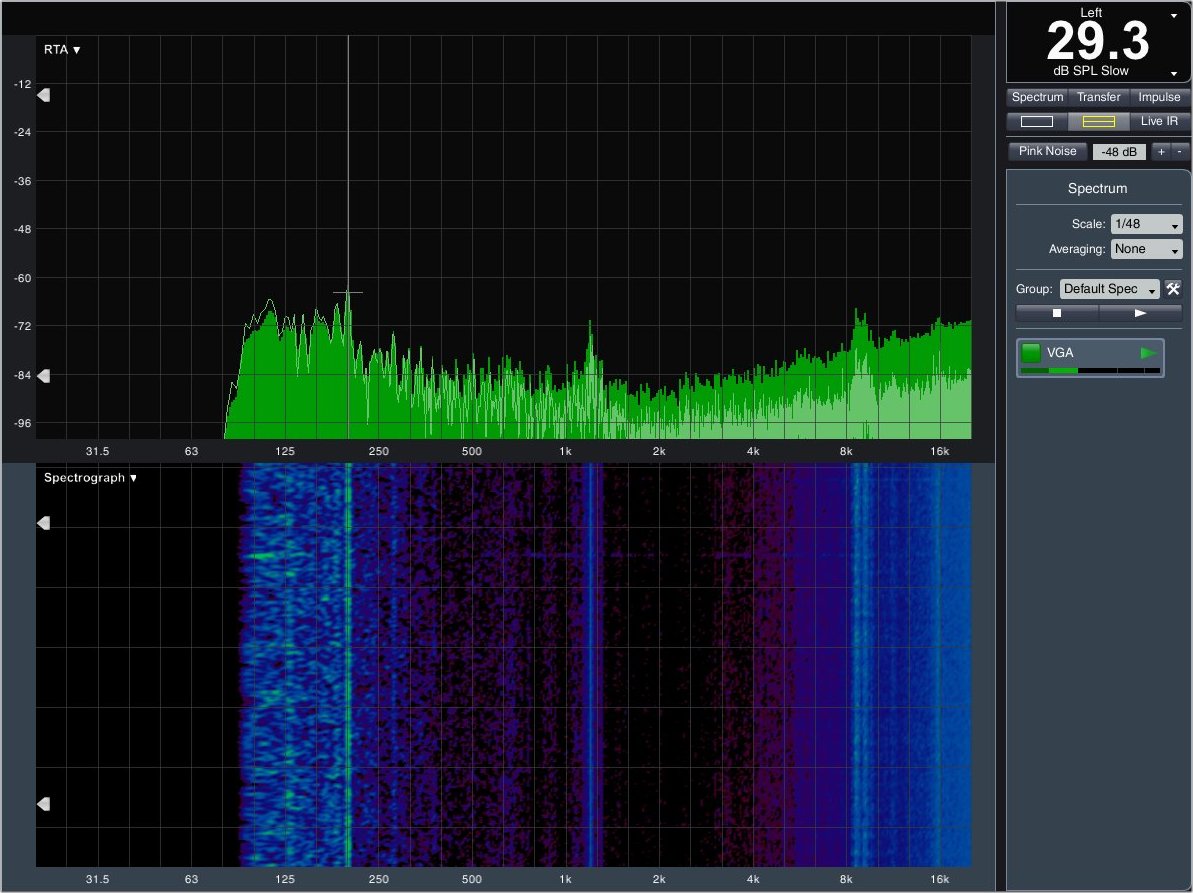
Technical data and interim conclusion
Let's take a look at the technical data and individual details of the graphics card:
- 1 - Einführung und Übersicht
- 2 - EVGA GeForce GTX 1060 Superclocked
- 3 - Gainward GeForce GTX 1060 Phoenix GS
- 4 - Gigabyte GeForce GTX 1060 G1 Gaming
- 5 - inno3D GeForce GTX 1060 Gaming OC
- 6 - MSI GeForce GTX 1060 Gaming X 3G
- 7 - MSI GeForce GTX 1060 Gaming X 6G
- 8 - Nvidia GeForce GTX 1060 Founders Edition
- 9 - Palit GeForce GTX 1060 SuperJetstream
- 10 - [Neu] PNY GeForce GTX 1060 XLR8 OC Gaming
- 11 - Vergleich der Gaming-Performance
- 12 - Vergleich vom Temperatur, Lautstärke und Leistungsaufnahme
- 13 - Vergleichende Zusammenfassung und Fazit















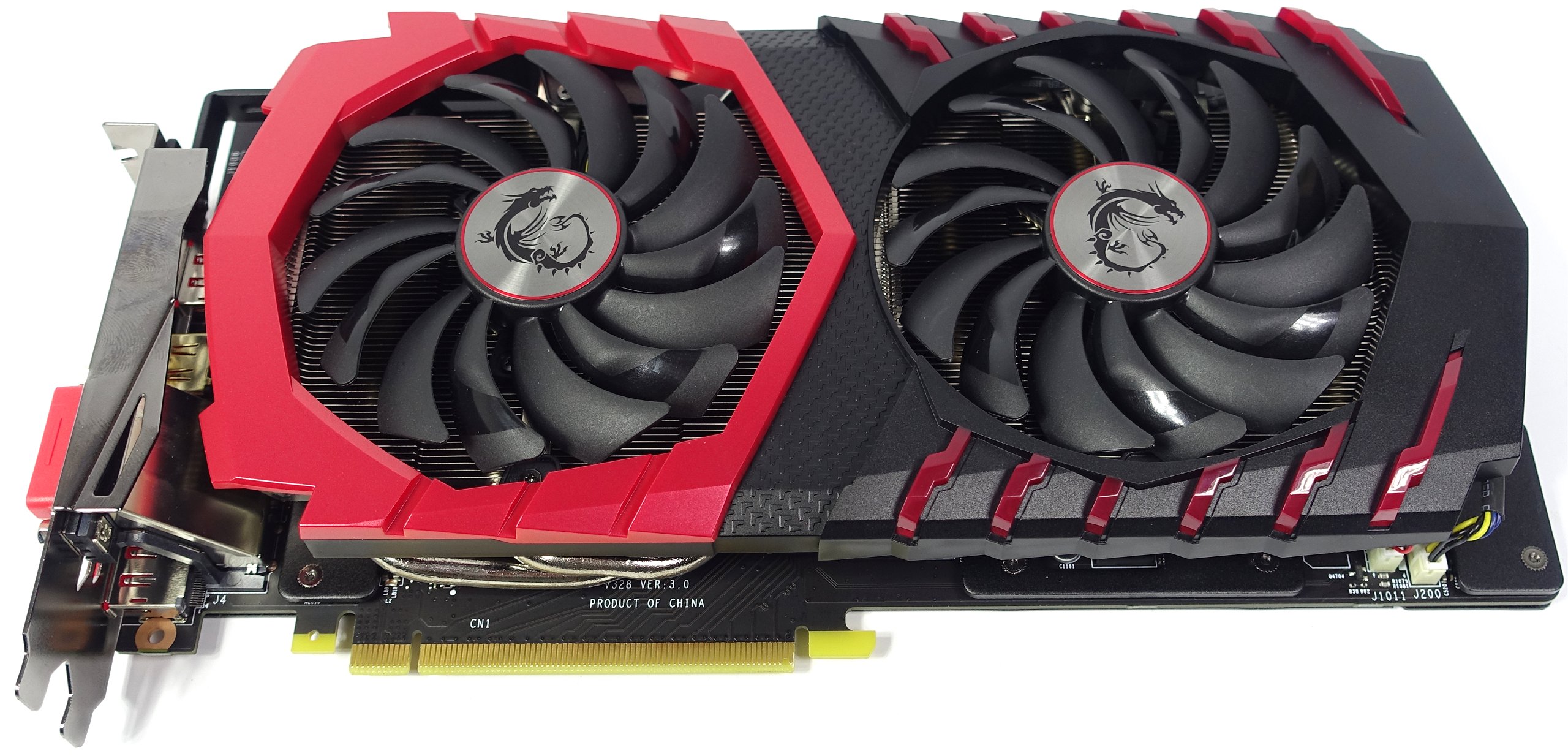

















Kommentieren